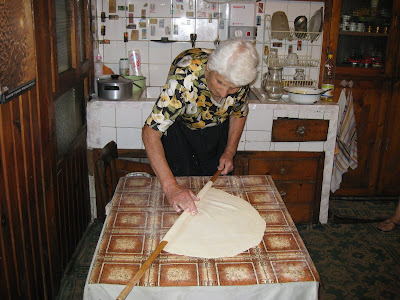Banitsa is a large round pastry 12" or more in diameter. It is great breakfast treat but can be eaten anytime. Although some people buy a commercial banitsa, the best are homemade. A good cook can be judged by her banitsa. The banitsa in these pictures is being prepared by Baba Venetka (and an assistant) in Shirley's house. "Baba" is the word for grandmother and is a title worn with pride and honor.
First the yeast dough is prepared from scratch and allowed to rise in a warm place after being divided in about ten portions.
One portion of dough is placed on a tabletop that has been dusted with flour. This portion of dough is first flatten by hand. Note the low table that is only a little above knee high on a short baba.

No, there is no rolling pin. A long round dowel works better as you will see.

The dowel is not used like a rolling pin. Rather the dowel is used to roll up the dough on the stick.

After the dowel is completely rolled up on the dowel, Baba will roll the dowel back and forth a little and work with her hands to spread out the dough so that it becomes wider on the stick. You can't do that with a rolling pin.


Then Baba unrolls the dough back onto the table so it is a flat circle again. Then she turns the dough 90 degree and starts rolling it back up on the stick again and again will work with her fingers to widen the dough. Of course as the dough is widened it becomes thinner and thinner.
Note how much bigger the dough circle is now.

When she finishes with this one portion of dough, it is almost paper thin. She drapes it on the dowel to carry it. If she tried to carry it by one edge, it would tear because it is so thin.

Now she pours a small amount of vegetable oil on the circle. In Bulgaria vegetable oil is most likely made from sunflowers which are grown in Bulgaria.

After the oil she sprinkles a mixture of egg and feta cheese.

The process will continue on the next post on this blog.













No comments:
Post a Comment